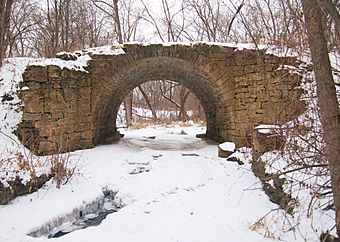Point Douglas–St. Louis River Road Bridge facts for kids
Quick facts for kids |
|
|
Point Douglas-St. Louis River Road Bridge
|
|

The Point Douglas–St. Louis River Road Bridge viewed from the east
|
|
| Location | Off County Highway 5, Stillwater Township, Minnesota |
|---|---|
| Area | 0.5 acres (0.20 ha) |
| Built | 1865 |
| Architect | William Willim |
| MPS | Washington County MRA (AD) |
| NRHP reference No. | 75001033 |
| Designated | February 24, 1975 |
The Point Douglas–St. Louis River Road Bridge is a very old stone bridge in Minnesota. It was built in 1865. This makes it the second oldest stone arch bridge known in the state. Only the Sibley's Ferry Bridge, built in 1864, is older.
This historic bridge is found in Stillwater Township. It was built to carry the Point Douglas to Superior Military Road over Brown's Creek. The bridge was added to the National Register of Historic Places in 1975. It is important because it shows us early engineering and how people traveled in Minnesota's past.
Contents
The Story of the Bridge
Building Early Roads in Minnesota
When Minnesota became a territory in 1849, there were not many roads. Most travel happened on rivers or old trails like the Red River Trails.
Henry Hastings Sibley, who later became Minnesota's first governor, asked the United States Congress for money in 1850. He wanted to build a network of military roads across Minnesota Territory.
The Minnesota Road Act was passed in July 1850. This law allowed for roads like the Point Douglas to Superior Military Road. This road was planned to go from Point Douglas (near Hastings) through towns like Stillwater and Taylors Falls. It was supposed to reach the Saint Louis River near Lake Superior.
These "military roads" were meant for army troops to move quickly. However, people mostly used them for regular travel. They helped civilians get between towns and settle new areas.
How the Bridge Was Built
James H. Simpson, an officer in the U.S. Army, was in charge of building these roads. The first bridge over Brown's Creek was made of wood.
When Minnesota became a state, the federal government stopped helping with road projects. By 1863, the wooden bridge needed to be replaced.
On September 2, 1863, Michael Hanley and Fredrick Curtis were hired to build a new stone bridge. But their work was not accepted by the county for unknown reasons.
Then, on August 3, 1865, Commissioner William Willim was asked to lead the building of a new bridge. His bridge was finished and accepted by the county on October 17, 1865. It cost $1197.38.
The Point Douglas to St. Louis River Road was never fully completed as a military road. Congress only gave small amounts of money at a time. By 1858, when Minnesota became a state, about two-thirds of the road was built.
The Bridge's Later Life
The bridge is made of limestone found nearby. William Willim, who built it, was also a stone and plaster contractor.
The stone bridge was used until about 1891. Then, a wider wooden bridge was built about 200 feet (61 m) to the east. The road was moved to this new bridge.
In 1905, a local miller used the old stone bridge as part of a three-story mill. The mill did not do well and was taken down in 1927. Only the stone bridge remained.



